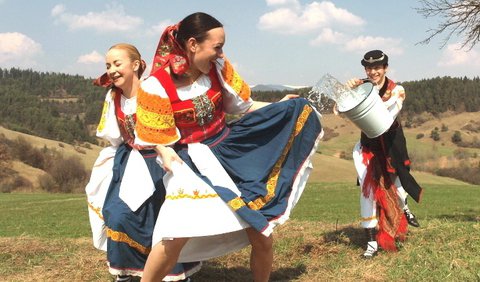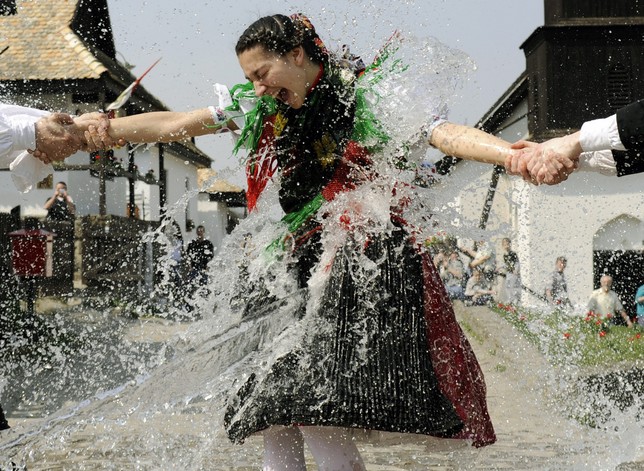According to tradition, packs of testosterone-fueled boys set out Monday morning and roam the town, going to the homes of all the girls they like or know. They barge into the house, locate the girl, and drag her out front where they dump a bucket of water over her, or drench her with a garden hose, clothes on and everything. Sometimes, they'll simply go inside and carry her into the shower or bathtub. Brothers and fathers will get involved too, and are likely to be the ones who let the other guys inside.
Then, while the girl is soaking wet, the boys will spray her with copious amounts of noxiously cheap perfume. The guys may also carry around a specially made willow stick, called a korbáč, which is used to whip the girl on the rear or the legs. Once the boys are done, they are invited by the girl's family to stay, where their efforts are rewarded with piles of food and alcohol. The family may also give them chocolate and/or money. The boys then move on to their next victim and repeat, until they're too drunk to stand up.
Of course, this tradition has waned quite considerably over the years, especially in more urban areas. In the old days, guys would have to chase the girls through the village and, once they caught them, submerge or toss them in the nearest creek. Today, a woman is much more likely to be awakened in the morning by a snickering brother or father pouring a glass of water in her ear, or perhaps spraying her with scented water from a flask. You're obviously not going to see women being chased through the streets of Bratislava. However, the drinking and eating remains integral to the holiday.
Naturally, women have become increasingly weary of this tradition. Being drenched and whipped all morning while men get to sit around eating and drinking gets old after a while. Terezia says that traditionally, women could exact revenge on the men the following day, but the chance to do so didn't always present itself, since by then everyone was back at work or school. But while many women claim to dread this tradition, Terezia says that for teenage girls it becomes something of a popularity contest. The more guys who come to a girl's house to drench her, the more popular she is, and she can come to school the next morning and brag about how many visitors she had.
But what the hell is the point of all this? This was believed to cleanse and purify the woman, preserve her beauty and vitality, while the whipping is somehow supposed to make her more fertile. According to custom, "Mid-April was celebrated as a time of rebirth: processions were used to drive away evil spirits, houses were decorated with vegetation (the egg survives today as a symbol of life), and whipping and water were employed to ensure a young woman's fertility and beauty. It was believed that the vitality from the young twigs entwined in the whip would flow into the woman's body." Never mind that this tradition sounds a bit like what you'd get if a bunch of monosyllabic, backwards baseball cap-wearing fratboys sat around thinking of ways to make Easter more exciting.
 |
| The miracles of medieval science: hitting a woman with a Korbáč to make her more fertile. |
At any rate, while kids in the US innocently hunt for pastel-dyed or candy-filled eggs that they've been told have been hidden by a creepy man-sized rabbit, in Slovakia, roving gangs of young men hunt for girls to whip and douce with water. And I have to emphasize, Easter really is an important holiday here. So important, in fact, that as I write on this Friday morning, Bratislava's streets are already deserted to the point where I think I just saw a tumbleweed blowing down the sidewalk. With everyone presumably having gone back home for the long weekend, it's like a ghost town here!


No comments:
Post a Comment